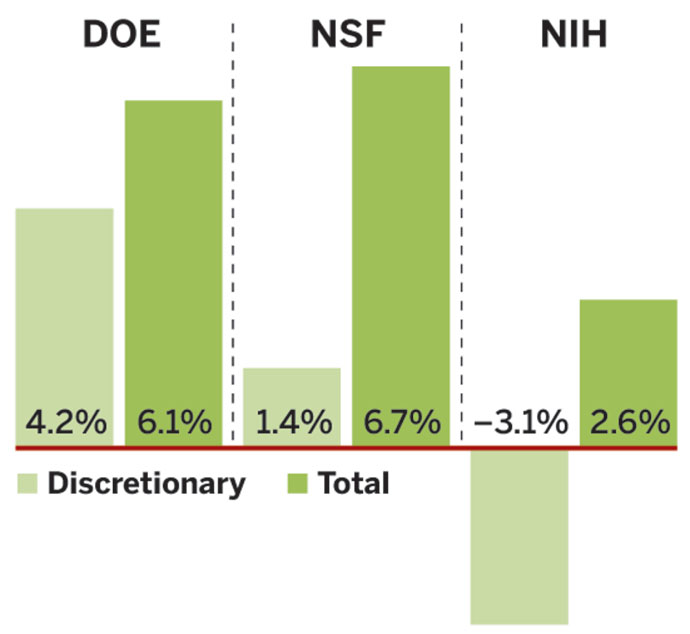Advertisement
Grab your lab coat. Let's get started
Welcome!
Welcome!
Create an account below to get 6 C&EN articles per month, receive newsletters and more - all free.
It seems this is your first time logging in online. Please enter the following information to continue.
As an ACS member you automatically get access to this site. All we need is few more details to create your reading experience.
Not you? Sign in with a different account.
Not you? Sign in with a different account.
ERROR 1
ERROR 1
ERROR 2
ERROR 2
ERROR 2
ERROR 2
ERROR 2
Password and Confirm password must match.
If you have an ACS member number, please enter it here so we can link this account to your membership. (optional)
ERROR 2
ACS values your privacy. By submitting your information, you are gaining access to C&EN and subscribing to our weekly newsletter. We use the information you provide to make your reading experience better, and we will never sell your data to third party members.
Policy
NIH: Funding Remains Flat, But Offers Relief From Sequestration
by Britt E. Erickson
April 22, 2013
| A version of this story appeared in
Volume 91, Issue 16

Under the President’s proposed fiscal 2014 budget, the National Institutes of Health would receive $31.3 billion, a modest increase of $471 million or 1.5% compared with fiscal 2012. Despite NIH’s relatively flat budget, advocates for biomedical research say the proposal offers welcome relief to the 5.1% across-the-board cuts the agency received earlier this year when sequestration went into effect.
NIH Director Francis S. Collins called the proposed budget “an encouragement” after what the agency has been through in fiscal 2013.
With the additional money, NIH plans to spend $41 million tackling the challenges and opportunities provided by “big data.” In particular, the agency plans to launch a program called Big Data to Knowledge (BD2K). The program aims to make it easier for researchers to use and share large, complex biomedical data sets. In addition, NIH is hoping the program will lead to new analytical methods and software, as well as enhance the training of data scientists and engineers.
NIH will also spend $32 million in 2014 on a new program called Building Infrastructure Leading to Diversity (BUILD) to enhance the diversity of the biomedical research workforce. “We have not done as well as we wish we had in terms of recruiting the best and brightest from all groups,” Collins says. “There are traditionally underrepresented groups that clearly are not finding their way into our workforce in the kinds of numbers that would be good for us and good for them.”
The new diversity program will provide opportunities for undergraduate students from traditionally underrepresented groups to work full-time in biomedical research laboratories. It will also set up a national network to provide mentoring for researchers who often fail to receive this assistance because of the current lack of such networks.
In 2014, NIH also intends to invest $40 million in the recently announced Brain Research through Advancing Innovative Neurotechnologies (BRAIN) Initiative. The goal of this effort is to accelerate new technologies to produce real-time pictures of complex circuitry in the brain so that researchers can unravel how brain function is linked to behavior, learning, and disease.
The National Institute on Aging is one of the few NIH institutes that will see a significant increase under the proposed 2014 budget—$73 million or 6.5% compared with 2012, for a total 2014 budget of $1.2 billion. The extra money will be used to support the development of new drugs for Alzheimer’s disease.
The National Center for Advancing Translational Sciences, NIH’s newest center focused on improving the drug development process, will also see a hefty increase in its budget in fiscal 2014. The center is slated to receive $666 million in 2014, $92 million more than in 2012, or a 15.9% increase. Of that additional money, the Cures Acceleration Network (CAN) will receive $40 million, bringing its total budget up to $50 million. CAN aims to reduce barriers between drug discovery and clinical trials.
Under the proposed budget, NIH would be able to fund 10,269 new and competing research project grants, an increase of 1,283 grants or 14.3% compared with 2012. Considering all competing and noncompeting research project grants, the agency would be able to fund 36,610 grants, an increase of 351 grants or 1.0% compared with 2012.
Advocates for biomedical research welcome the proposed budget but warn that Congress may not go along with the President’s plan to reverse sequestration. The President’s 2014 budget proposal “offers a lifeline for medical research to replace sequestration’s damaging footprints,” says Mary Woolley, president and chief executive officer of Research!America, a group that advocates for increased support for health-related research. “These increases would take our nation in the right direction, but we’re concerned that budget proposals from Congress—one each from the House and Senate—unlike the President’s, fail to reverse sequestration.”
Others point out that NIH’s budget has not kept up with the biomedical inflation rate, which is projected to be 2.5% for 2013, for more than a decade. “While we applaud the proposed increase in medical research funding in the President’s budget, it is important to note that this still means that the NIH budget has failed to keep pace with biomedical inflation for 11 consecutive years,” says Darrell G. Kirch, president and CEO of the Association of American Medical Colleges, a nonprofit that represents the academic medical community. That situation, he notes, “will have dramatic consequences on the pace of medical innovation and will harm communities around the nation.”
MORE ON THIS STORY
- - Science Funding
- - NSF: Basic Science Set To Grow
- - NIH: Funding Remains Flat, But Offers Relief From Sequestration
- - Defense: Cuts Hit Systems Development
- - DHS: Huge Jump To Support New Biocontainment Lab
- - Energy: Renewable Energy Set For Boost
- - NASA: Support To Enable Future Asteroid Mission
- - Commerce: NIST, NOAA Get Budget Hikes
- - Agriculture: Competitive Research Funds Set To Rise
- - EPA: Research On Contaminated Sites Scaled Back
- - Interagency Initiatives: Education Reshuffled, Climate Up, Nanotech Reduced
- - FDA User Fees Continue To Climb




Join the conversation
Contact the reporter
Submit a Letter to the Editor for publication
Engage with us on Twitter